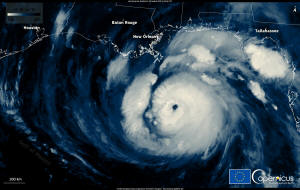Ida pounds Louisiana, topples power lines and plunges New Orleans into
darkness
 Send a link to a friend
Send a link to a friend
 [August 30, 2021]
By Devika Krishna Kumar [August 30, 2021]
By Devika Krishna Kumar
NEW ORLEANS (Reuters) -Hurricane Ida
pounded Louisiana after sweeping ashore from the Gulf of Mexico,
flooding wide areas under heavy surf and torrential rains as fierce
winds toppled trees and power lines, plunging New Orleans into darkness
after nightfall.
Ida weakened into a tropical storm over southwestern Mississippi early
on Monday, the National Hurricane Center said, but it is expected to
continue unleashing heavy downpours "likely to result in
life-threatening" flooding.
The full extent of storm damage remained to be seen at daybreak.
Sunday night, the sheriff's office in Ascension Parish reported the
first known U.S. fatality from the storm, a 60-year-old man killed by a
tree falling on his home near Baton Rouge, the state capital.
Ida, the first major hurricane to strike the United States this year,
made landfall around noon on Sunday as a ferocious Category 4 storm over
Port Fourchon, a hub of the Gulf's offshore oil industry, packing
sustained winds of up to 150 miles per hour (240 km per hour).
Its arrival came 16 years to the day after Hurricane Katrina, one of the
most catastrophic and deadly U.S. storms on record, struck the Gulf
Coast, and about a year after the last Category 4 hurricane, Laura,
battered Louisiana.

President Joe Biden declared a major disaster in the state, ordering
federal assistance to bolster recovery efforts in more than two dozen
storm-stricken parishes.
Ida crashed ashore as Louisiana was already reeling from a resurgence of
COVID-19 infections that has strained the state's healthcare system,
with an estimated 2,450 COVID-19 patients hospitalized statewide, many
in intensive care units.
A loss of generator power at the Thibodaux Regional Health System
hospital in Lafourche Parish, southwest of New Orleans, forced medical
workers to manually assist respirator patients with breathing while they
were moved to another floor, the state Health Department confirmed to
Reuters.
Within 12 hours of landfall, Ida had weakened into a Category 1
hurricane on the five-level Saffir-Simpson scale, with top winds clocked
at 85 mph (135 kph) as the storm pushed about 100 miles inland past New
Orleans, Louisiana's largest city, early on Monday.
By then, Ida had plowed a destructive path that submerged much of the
state's coastline under several feet of surf, with flash flooding
reported by the National Hurricane Center across southeastern Louisiana.
Nearly all offshore Gulf oil production was suspended in advance of the
storm, and major ports along the Louisiana and Mississippi coasts were
closed to shipping.
WIDESPREAD OUTAGES
Power was knocked out Sunday night to the entire New Orleans
metropolitan area following the failure of all eight transmission lines
that deliver electricity to the city, the utility company Entergy
Louisiana reported.
One transmission tower collapsed into the Mississippi River, the
Jefferson Parish Emergency Management Department said.
[to top of second column]
|

A satellite image shows Hurricane Ida in the Gulf of Mexico August
29, 2021. European Union, Copernicus Sentinel-3 Imagery, Processed
by DG DEFIS/Handout via REUTERS

More than 1 million Louisiana homes and businesses in
all were without electricity by late Sunday night, according to the
tracking site Poweroutage.US.
Residents of the most vulnerable coastal areas were ordered to
evacuate days ahead of the storm. Those riding out the storm in
their homes in New Orleans braced for the toughest test yet of major
upgrades to a levee system constructed following devastating
floods in 2005 from Katrina, a hurricane that claimed some 1,800
lives.
"I almost found myself in a panic attack when news announced this
was the anniversary of Katrina," said Janet Rucker, a lifelong New
Orleans resident who took shelter in a downtown hotel with her dog,
Deuce. "This is just not good for our nerves and our psyche."
The U.S. Army Corps of Engineers said the newly reinforced New
Orleans levees were expected to hold, though they said they said the
flood walls could be overtopped in some places.
Hundreds of miles of new levees were built around New Orleans after
flooding from Katrina inundated much of the low-lying city,
especially historically Black neighborhoods.
Inundation from Ida's storm surge - high surf driven by the
hurricane's winds - was reported to be exceeding predicted levels of
6 feet (1.8 m) along parts of the coast. Videos posted on social
media showed storm surge flooding had transformed sections of
Highway 90 along the Louisiana and Mississippi coast into a choppy
river.
"We're as prepared as we can be, but we're worried about those
levees," said Kirk Lepine, president of Plaquemines Parish, one of
the most vulnerable areas along the Gulf Coast.
The parish later issued an alert on Facebook urging residents of one
area to seek higher ground after reports of an overtopped levee.

(Reporting by Devika Krishna Kumar in New Orleans; Additional
reporting by Jessica Resnick-Ault and Jonathan Allen in New York,
Erwin Seba in Houston, Rich McKay in Atlanta, Laura Sanicola, Linda
So and Trevor Hunnicutt in Washington, Liz Hampton in Denver, and
Arpan Varghese, Kanishka Singh, Bhargav Acharya and Nakul Iyer in
Bengaluru; Writing by Steve Gorman; Editing by Richard Pullin and
Nick Macfie)
[© 2021 Thomson Reuters. All rights
reserved.] Copyright 2021 Reuters. All rights reserved. This material may not be published,
broadcast, rewritten or redistributed.
Thompson Reuters is solely responsible for this content. |